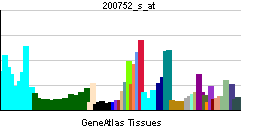CAPN1
| Calpain 1, (mu/I) large subunit | |||||||||||||
|---|---|---|---|---|---|---|---|---|---|---|---|---|---|
 PDB rendering based on 1zcm. | |||||||||||||
| |||||||||||||
| Identifiers | |||||||||||||
| Symbols | CAPN1 ; CANP; CANPL1; muCANP; muCL | ||||||||||||
| External IDs | Template:OMIM5 Template:MGI HomoloGene: 3800 | ||||||||||||
| |||||||||||||
| RNA expression pattern | |||||||||||||
 | |||||||||||||
| More reference expression data | |||||||||||||
| Orthologs | |||||||||||||
| Template:GNF Ortholog box | |||||||||||||
| Species | Human | Mouse | |||||||||||
| Entrez | n/a | n/a | |||||||||||
| Ensembl | n/a | n/a | |||||||||||
| UniProt | n/a | n/a | |||||||||||
| RefSeq (mRNA) | n/a | n/a | |||||||||||
| RefSeq (protein) | n/a | n/a | |||||||||||
| Location (UCSC) | n/a | n/a | |||||||||||
| PubMed search | n/a | n/a | |||||||||||
Calpain 1, (mu/I) large subunit, also known as CAPN1, is a human gene.[1]
The calpains, calcium-activated neutral proteases, are nonlysosomal, intracellular cysteine proteases. The mammalian calpains include ubiquitous, stomach-specific, and muscle-specific proteins. The ubiquitous enzymes consist of heterodimers with distinct large, catalytic subunits associated with a common small, regulatory subunit. This gene encodes the large subunit of the ubiquitous enzyme, calpain 1.[1]
References
Further reading
- Suzuki K, Sorimachi H, Yoshizawa T; et al. (1996). "Calpain: novel family members, activation, and physiologic function". Biol. Chem. Hoppe-Seyler. 376 (9): 523–9. PMID 8561910.
- Huang Y, Wang KK (2001). "The calpain family and human disease". Trends in molecular medicine. 7 (8): 355–62. PMID 11516996.
- Goll DE, Thompson VF, Li H; et al. (2003). "The calpain system". Physiol. Rev. 83 (3): 731–801. doi:10.1152/physrev.00029.2002. PMID 12843408.
- Banik NL, DeVries GH, Neuberger T; et al. (1991). "Calcium-activated neutral proteinase (CANP; calpain) activity in Schwann cells: immunofluorescence localization and compartmentation of mu- and mCANP". J. Neurosci. Res. 29 (3): 346–54. doi:10.1002/jnr.490290310. PMID 1656060.
- Ohno S, Minoshima S, Kudoh J; et al. (1990). "Four genes for the calpain family locate on four distinct human chromosomes". Cytogenet. Cell Genet. 53 (4): 225–9. PMID 2209092.
- Sorimachi H, Ohmi S, Emori Y; et al. (1990). "A novel member of the calcium-dependent cysteine protease family". Biol. Chem. Hoppe-Seyler. 371 Suppl: 171–6. PMID 2400579.
- Harris AS, Croall DE, Morrow JS (1988). "The calmodulin-binding site in alpha-fodrin is near the calcium-dependent protease-I cleavage site". J. Biol. Chem. 263 (30): 15754–61. PMID 2844821.
- Aoki K, Imajoh S, Ohno S; et al. (1986). "Complete amino acid sequence of the large subunit of the low-Ca2+-requiring form of human Ca2+-activated neutral protease (muCANP) deduced from its cDNA sequence". FEBS Lett. 205 (2): 313–7. PMID 3017764.
- Ishiguro H, Higashiyama S, Namikawa C; et al. (1987). "Interaction of human calpains I and II with high molecular weight and low molecular weight kininogens and their heavy chain: mechanism of interaction and the role of divalent cations". Biochemistry. 26 (10): 2863–70. PMID 3038169.
- Morishita R, Nakayama H, Isobe T; et al. (1996). "Primary structure of a gamma subunit of G protein, gamma 12, and its phosphorylation by protein kinase C.". J. Biol. Chem. 270 (49): 29469–75. PMID 7493986.
- Kavita U, Mizel SB (1996). "Differential sensitivity of interleukin-1 alpha and -beta precursor proteins to cleavage by calpain, a calcium-dependent protease". J. Biol. Chem. 270 (46): 27758–65. PMID 7499244.
- Du X, Saido TC, Tsubuki S; et al. (1995). "Calpain cleavage of the cytoplasmic domain of the integrin beta 3 subunit". J. Biol. Chem. 270 (44): 26146–51. PMID 7592818.
- Bradford HN, Jameson BA, Adam AA; et al. (1994). "Contiguous binding and inhibitory sites on kininogens required for the inhibition of platelet calpain". J. Biol. Chem. 268 (35): 26546–51. PMID 8253784.
- Oda A, Ozaki K, Druker BJ; et al. (1996). "p120c-cbl is present in human blood platelets and is differentially involved in signaling by thrombopoietin and thrombin". Blood. 88 (4): 1330–8. PMID 8695851.
- Zhang W, Lane RD, Mellgren RL (1996). "The major calpain isozymes are long-lived proteins. Design of an antisense strategy for calpain depletion in cultured cells". J. Biol. Chem. 271 (31): 18825–30. PMID 8702541.
- Courseaux A, Grosgeorge J, Gaudray P; et al. (1997). "Definition of the minimal MEN1 candidate area based on a 5-Mb integrated map of proximal 11q13. The European Consortium on Men1, (GENEM 1; Groupe d'Etude des Néoplasies Endocriniennes Multiples de type 1)". Genomics. 37 (3): 354–65. PMID 8938448.
- Corasaniti MT, Navarra M, Catani MV; et al. (1997). "NMDA and HIV-1 coat protein, GP120, produce necrotic but not apoptotic cell death in human CHP100 neuroblastoma cultures via a mechanism involving calpain". Biochem. Biophys. Res. Commun. 229 (1): 299–304. doi:10.1006/bbrc.1996.1796. PMID 8954122.
- Stabach PR, Cianci CD, Glantz SB; et al. (1997). "Site-directed mutagenesis of alpha II spectrin at codon 1175 modulates its mu-calpain susceptibility". Biochemistry. 36 (1): 57–65. doi:10.1021/bi962034i. PMID 8993318.
- Norris FA, Atkins RC, Majerus PW (1997). "Inositol polyphosphate 4-phosphatase is inactivated by calpain-mediated proteolysis in stimulated human platelets". J. Biol. Chem. 272 (17): 10987–9. PMID 9110986.
| This protein-related article is a stub. You can help Wikipedia by expanding it. |